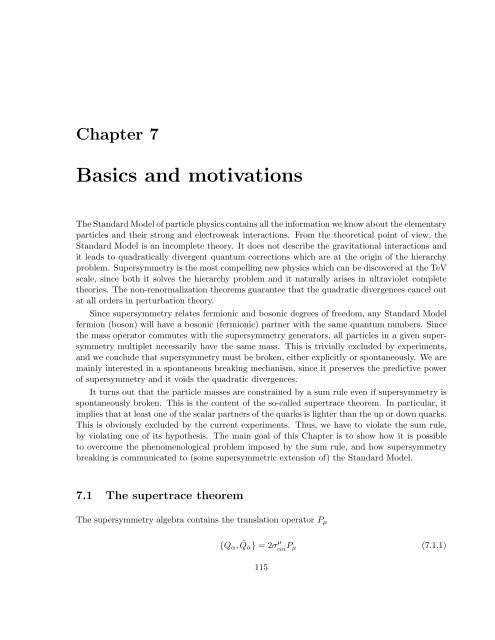Perturbative and non-perturbative infrared behavior of ...
Perturbative and non-perturbative infrared behavior of ...
Perturbative and non-perturbative infrared behavior of ...
Create successful ePaper yourself
Turn your PDF publications into a flip-book with our unique Google optimized e-Paper software.
Chapter 7<br />
Basics <strong>and</strong> motivations<br />
The St<strong>and</strong>ard Model <strong>of</strong> particle physics contains all the information we know about the elementary<br />
particles <strong>and</strong> their strong <strong>and</strong> electroweak interactions. From the theoretical point <strong>of</strong> view, the<br />
St<strong>and</strong>ard Model is an incomplete theory. It does not describe the gravitational interactions <strong>and</strong><br />
it leads to quadratically divergent quantum corrections which are at the origin <strong>of</strong> the hierarchy<br />
problem. Supersymmetry is the most compelling new physics which can be discovered at the TeV<br />
scale, since both it solves the hierarchy problem <strong>and</strong> it naturally arises in ultraviolet complete<br />
theories. The <strong>non</strong>-renormalization theorems guarantee that the quadratic divergences cancel out<br />
at all orders in perturbation theory.<br />
Since supersymmetry relates fermionic <strong>and</strong> bosonic degrees <strong>of</strong> freedom, any St<strong>and</strong>ard Model<br />
fermion (boson) will have a bosonic (fermionic) partner with the same quantum numbers. Since<br />
the mass operator commutes with the supersymmetry generators, all particles in a given supersymmetry<br />
multiplet necessarily have the same mass. This is trivially excluded by experiments,<br />
<strong>and</strong> we conclude that supersymmetry must be broken, either explicitly or spontaneously. We are<br />
mainly interested in a spontaneous breaking mechanism, since it preserves the predictive power<br />
<strong>of</strong> supersymmetry <strong>and</strong> it voids the quadratic divergences.<br />
It turns out that the particle masses are constrained by a sum rule even if supersymmetry is<br />
spontaneously broken. This is the content <strong>of</strong> the so-called supertrace theorem. In particular, it<br />
implies that at least one <strong>of</strong> the scalar partners <strong>of</strong> the quarks is lighter than the up or down quarks.<br />
This is obviously excluded by the current experiments. Thus, we have to violate the sum rule,<br />
by violating one <strong>of</strong> its hypothesis. The main goal <strong>of</strong> this Chapter is to show how it is possible<br />
to overcome the phenomenological problem imposed by the sum rule, <strong>and</strong> how supersymmetry<br />
breaking is communicated to (some supersymmetric extension <strong>of</strong>) the St<strong>and</strong>ard Model.<br />
7.1 The supertrace theorem<br />
The supersymmetry algebra contains the translation operator Pµ<br />
{Qα, ¯ Q ˙α} = 2σ µ<br />
α ˙α Pµ<br />
115<br />
(7.1.1)
















